An Unpowered Sensor Node for Real-Time Water Quality Assessment (Humic Acid Detection)
Abstract
:1. Introduction
2. Materials and Methods
2.1. The Sensing Node
2.2. The Base Station
3. Experimental Verification
4. Conclusions
Author Contributions
Funding
Conflicts of Interest
Abbreviations
| QPD | Quadrature Power Divider |
| QPC | Quadrature Power Coupler |
| PC | Power Combiner |
| PD | Power Detector |
| LPF | Low Pass Filter |
| RSC | Reference Sensitive Circuits |
| SSC | Sample Sensitive Circuits |
References
- World Economic Forum. The Global Risks Report 2017; World Economic Forum: Geneva, Switzerland, 2017. [Google Scholar]
- Allwood, G.; Wild, G.; Hinckley, S. Fiber bragg grating sensors for mainstream industrial processes. Electronics 2017, 6, 92. [Google Scholar] [CrossRef]
- Khorshidi, B.; Thundat, T.; Fleck, B.A.; Sadrzadeh, M. A novel approach toward fabrication of high performance thin film composite polyamide membranes. Sci. Rep. 2016, 6, 22069. [Google Scholar] [CrossRef] [PubMed]
- Park, S.J.; Hong, J.T.; Choi, S.J.; Kim, H.S.; Park, W.K.; Han, S.T.; Park, J.Y.; Lee, S.; Kim, D.S.; Ahn, Y.H. Detection of microorganisms using terahertz metamaterials. Sci. Rep. 2014, 4, 4988. [Google Scholar] [CrossRef] [PubMed] [Green Version]
- Højris, B.; Christensen, S.C.B.; Albrechtsen, H.-J.; Smith, C.; Dahlqvist, M. A novel, optical, on-line bacteria sensor for monitoring drinking water quality. Sci. Rep. 2016, 6, 23935. [Google Scholar] [CrossRef] [PubMed] [Green Version]
- Culler, D.E.; Mulder, H. Smart sensors to network the world. Sci. Am. 2004, 290, 84–91. [Google Scholar] [CrossRef] [PubMed]
- Tucker, R.; Ruffini, M.; Valcarenghi, L.; Campelo, D.R.; Simeonidou, D.; Du, L.; Marinescu, M.-C.; Middleton, C.; Yin, S.; Forde, T. Connected OFCity: Technology innovations for a smart city project. IEEE/OSA J. Opt. Commun. Networking 2017, 9, A245–A255. [Google Scholar] [CrossRef]
- Bouk, S.H.; Ahmed, S.H.; Kim, D.; Song, H. Named-data-networking-based ITS for smart cities. IEEE Commun. Mag. 2017, 55, 105–111. [Google Scholar] [CrossRef]
- Li, M.; Lin, H.-J. Design and implementation of smart home control systems based on wireless sensor networks and power line communications. IEEE Trans. Ind. Electron. 2015, 62, 4430–4442. [Google Scholar] [CrossRef]
- Im, H.; Lee, S.; Naqi, M.; Lee, C.; Kim, S. Flexible PI-Based Plant Drought Stress Sensor for Real-Time Monitoring System in Smart Farm. Electronics 2018, 7, 114. [Google Scholar] [CrossRef]
- Mirzavand, R.; Honari, M.M.; Mousavi, P. High-Resolution Balanced Microwave Material Sensor with Extended Dielectric Range. IEEE Trans. Ind. Electron. 2017, 64, 1552–1560. [Google Scholar] [CrossRef]
- Mirzavand, R.; Honari, M.M.; Mousavi, P. High-Resolution Dielectric Sensor Based on Injection-Locked Oscillators. IEEE Sens. J. 2017, 18, 141–148. [Google Scholar] [CrossRef]
- Donelli, M.; Manekiya, M. Development of Environmental Long Range RFID Sensors Based on the Modulated Scattering Technique. Electronics 2018, 7, 106. [Google Scholar] [CrossRef]
- Visser, H.J.; Vullers, R.J.M. RF energy harvesting and transport for wireless sensor network applications: Principles and requirements. Proc. IEEE 2013, 101, 1410–1423. [Google Scholar] [CrossRef]
- Huang, H.; Chen, P.-Y.; Hung, C.-H.; Gharpurey, R.; Akinwande, D. A zero power harmonic transponder sensor for ubiquitous wireless μL liquid-volume monitoring. Sci. Rep. 2016, 6, 18795. [Google Scholar] [CrossRef] [PubMed] [Green Version]
- Zhang, J.; Tian, G.Y.; Marindra, A.M.J.; Sunny, A.I.; Zhao, A.B. A review of passive RFID tag antenna-based sensors and systems for structural health monitoring applications. Sensors 2017, 17, 265. [Google Scholar] [CrossRef] [PubMed]
- Linz, S.; Oesterle, F.; Talai, A.; Lindner, S.; Mann, S.; Barbon, F.; Weigel, R.; Koelpin, A. 100 GHz reflectometer for sensitivity analysis of MEMS sensors comprising an intermediate frequency six-port receiver. In Proceedings of the 2015 IEEE Topical Conference on Wireless Sensors and Sensor Networks (WiSNet), San Diego, CA, USA, 25–28 January 2015. [Google Scholar]
- Vinci, G.; Koelpin, A. Progress of six-port technology for industrial radar applications. In Proceedings of the 2016 IEEE Topical Conference on Wireless Sensors and Sensor Networks (WiSNet), Austin, TX, USA, 24–27 January 2016. [Google Scholar]
- Mann, S.; Linz, S.; Erhardt, S.; Lindner, S.; Lurz, F.; Maune, H.; Weigel, R.; Koelpin, A. Differential measuring dual six-port concept and antenna design for an inline foil thickness sensor. In Proceedings of the 2016 German Microwave Conference (GeMiC), Bochum, Germany, 14–16 March 2016. [Google Scholar]
- Kuo, H.-C.; Lin, C.-C.; Yu, C.-H.; Lo, P.-H.; Lyu, J.-Y.; Chou, C.-C.; Chuang, H.-R. A fully integrated 60-GHz CMOS direct-conversion Doppler radar RF sensor with clutter canceller for single-antenna noncontact human vital-signs detection. IEEE Trans. Microwave Theory Tech. 2016, 64, 1018–1028. [Google Scholar] [CrossRef]
- Von der Mark, S.; Huber, M.; Boeck, G. 24 GHz direct conversion transceiver for sensor networks. In Proceedings of the 2007 IEEE Wireless Communications and Networking Conference, Kowloon, China, 11–15 March 2007. [Google Scholar]
- Cook, B.S.; Vyas, R.; Kim, S.; Thai, T.; Le, T.; Traille, A.; Aubert, H.; Tentzeris, M.M. RFID-based sensors for zero-power autonomous wireless sensor networks. IEEE Sens. J. 2014, 14, 2419–2431. [Google Scholar] [CrossRef]
- Adhikary, M.; Biswas, A.; Akhtar, M.J. Active Integrated Antenna Based Permittivity Sensing Tag. IEEE sens. let. 2017, 1, 1–4. [Google Scholar] [CrossRef]
- Lobato-Morales, H.; Corona-Chavez, A.; Olvera-Cervantes, J.L.; Chávez-Pérez, R.A.; Medina-Monroy, J.L. Wireless sensing of complex dielectric permittivity of liquids based on the RFID. IEEE Trans. Microwave Theory Tech. 2014, 62, 2160–2167. [Google Scholar] [CrossRef]
- Bouaziz, S.; Chebila, F.; Traille, A.; Pons, P.; Aubert, H.; Tentzeris, M. Novel micro-fluidic structures for wireless passive temperature telemetry medical systems using radar interrogation techniques in Ka-band. IEEE Antennas Wirel. Propag. Lett. 2012, 11, 1706–1709. [Google Scholar] [CrossRef]
- Cole, A.J.; Young, P.R. Chipless Liquid Sensing Using a Slotted Cylindrical Resonator. IEEE Sens. J. 2017, 18, 149–156. [Google Scholar] [CrossRef]
- Li, J.; Bosisio, R.G.; Wu, K. Computer and measurement simulation of a new digital receiver operating directly at millimeter-wave frequencies. IEEE Trans. Microwave Theory Tech. 1995, 43, 2766–2772. [Google Scholar] [CrossRef]
- Mirzavand, R.; Mohammadi, A.; Abdipour, A. Low-cost implementation of broadband microwave receivers in Ka-band using multiport structures. IET Microwaves Antennas Propag. 2009, 3, 483–491. [Google Scholar] [CrossRef]
- Mirzavand, R.; Mohammadi, A.; Ghannouchi, F.M. Five-port microwave receiver architectures and applications. IEEE Commun. Mag. 2010, 48, 30–36. [Google Scholar] [CrossRef]
- Beikmirza, M.R.; Mohammadi, A.; Mirzavand, R. Power amplifier linearisation using digital predistortion and multi-port techniques. IET Sci. Meas. Technol. 2016, 10, 467–476. [Google Scholar] [CrossRef]
- Mirzavand, R.; Honari, M.M.; Mousavi, P. N-ZERO direct conversion wireless sensor based on six-port structures. In Proceedings of the 2017 IEEE MTT-S International Microwave Symposium (IMS), Honololu, HI, USA, 4–9 June 2017. [Google Scholar]
- Mirzavand, R.; Honari, M.M.; Mousavi, P. Direct-conversion sensor for wireless sensing networks. IEEE Trans. Ind. Electron. 2017, 64, 9675–9682. [Google Scholar] [CrossRef]
- Berube, D.; Ghannouchi, F.M.; Savard, P. A comparative study of four open-ended coaxial probe models for permittivity measurements of lossy dielectric/biological materials at microwave frequencies. IEEE Trans. Microwave Theory Tech. 1996, 44, 1928–1934. [Google Scholar] [CrossRef]
- Li, R.; Pan, B.; Laskar, J.; Tentzeris, M.M. A Novel Low-Profile Broadband Dual-Frequency Planar Antenna for Wireless Handsets. IEEE Trans. Antennas Propag. 2008, 56, 1155–1162. [Google Scholar] [CrossRef]
- La Gioia, A.; Porter, E.; Merunka, I.; Shahzad, A.; Salahuddin, S.; Jones, M.; O’Halloran, M. Open-Ended Coaxial Probe Technique for Dielectric Measurement of Biological Tissues: Challenges and Common Practices. Diagnostics 2018, 8, 40. [Google Scholar] [CrossRef] [PubMed]
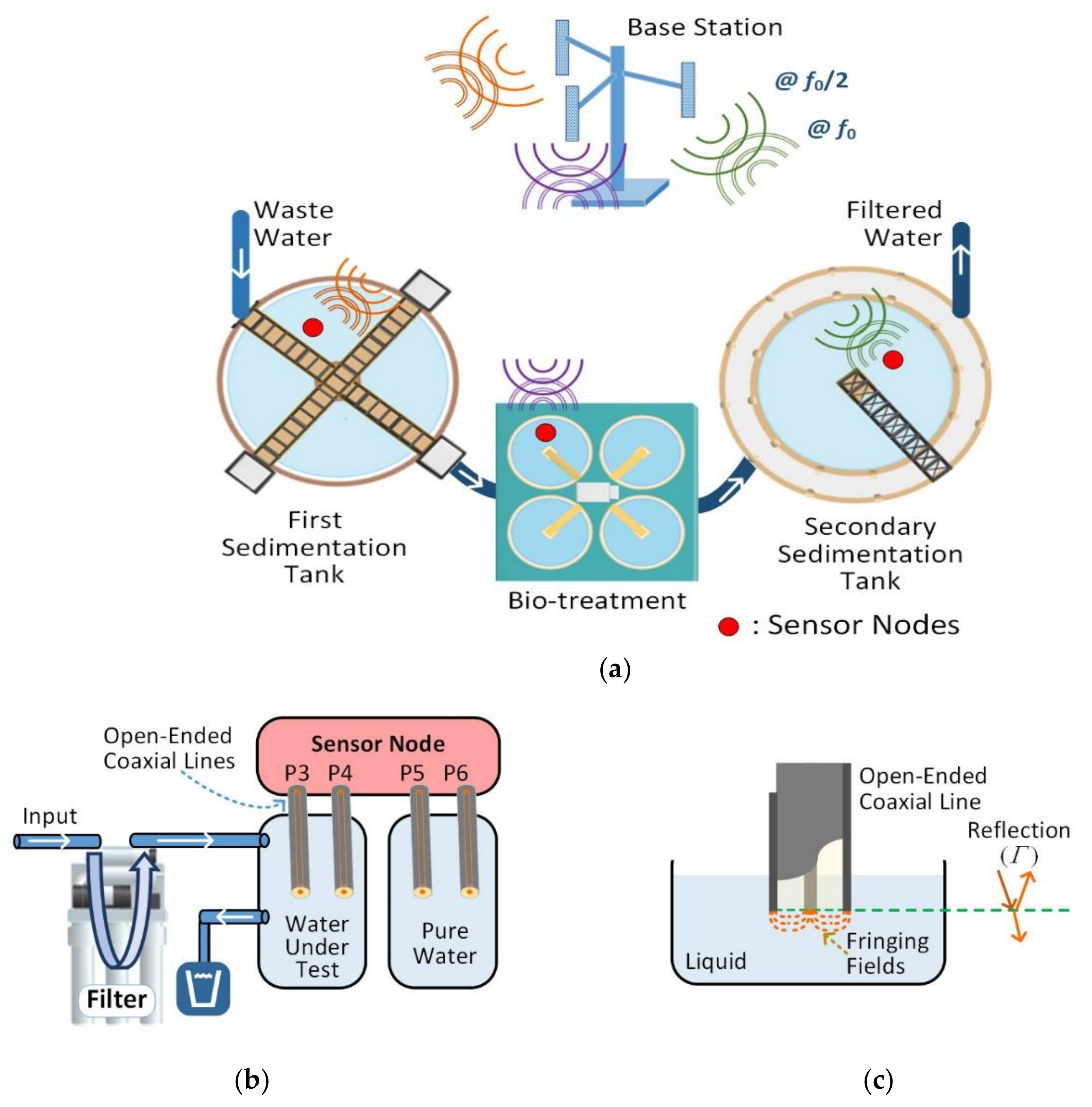

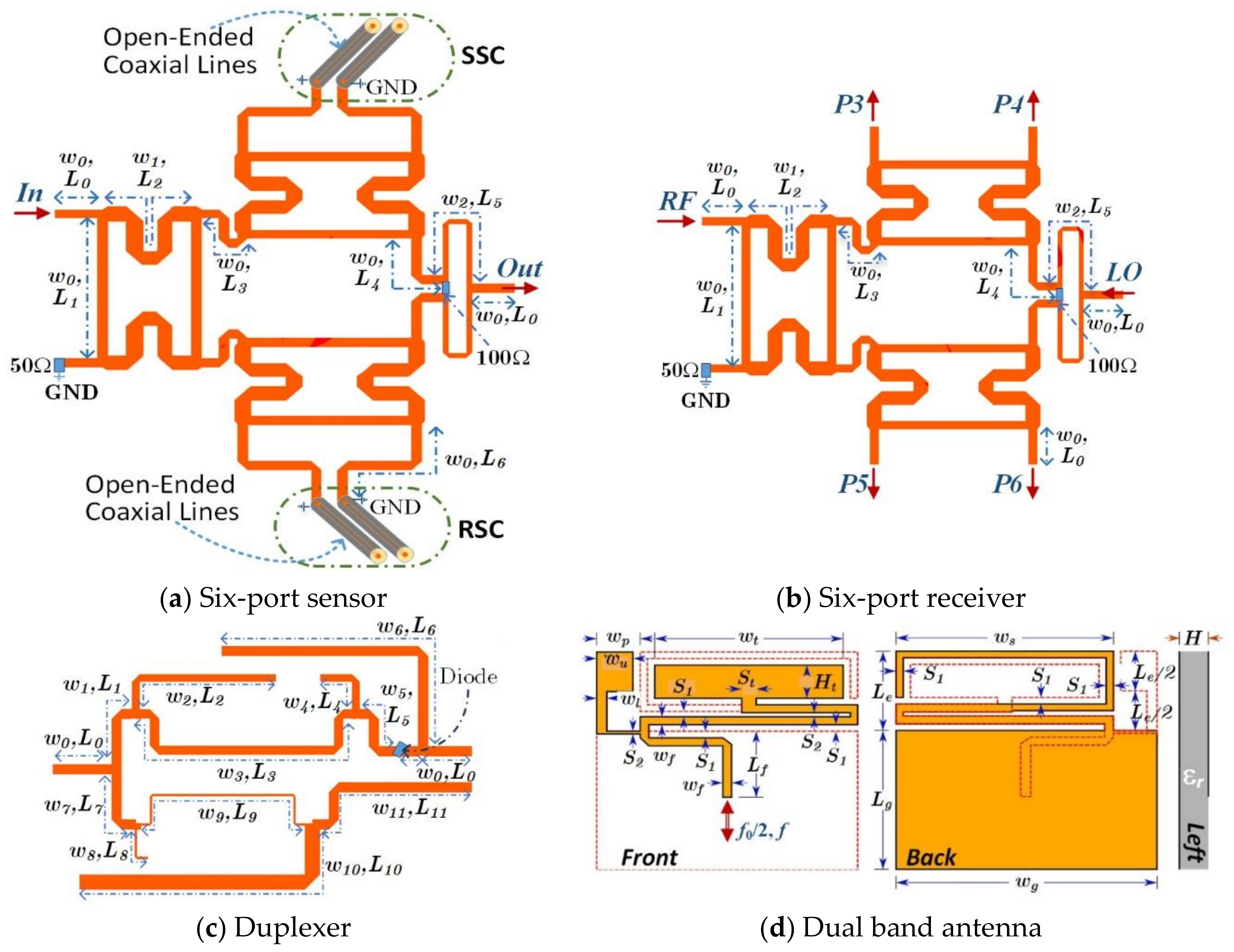
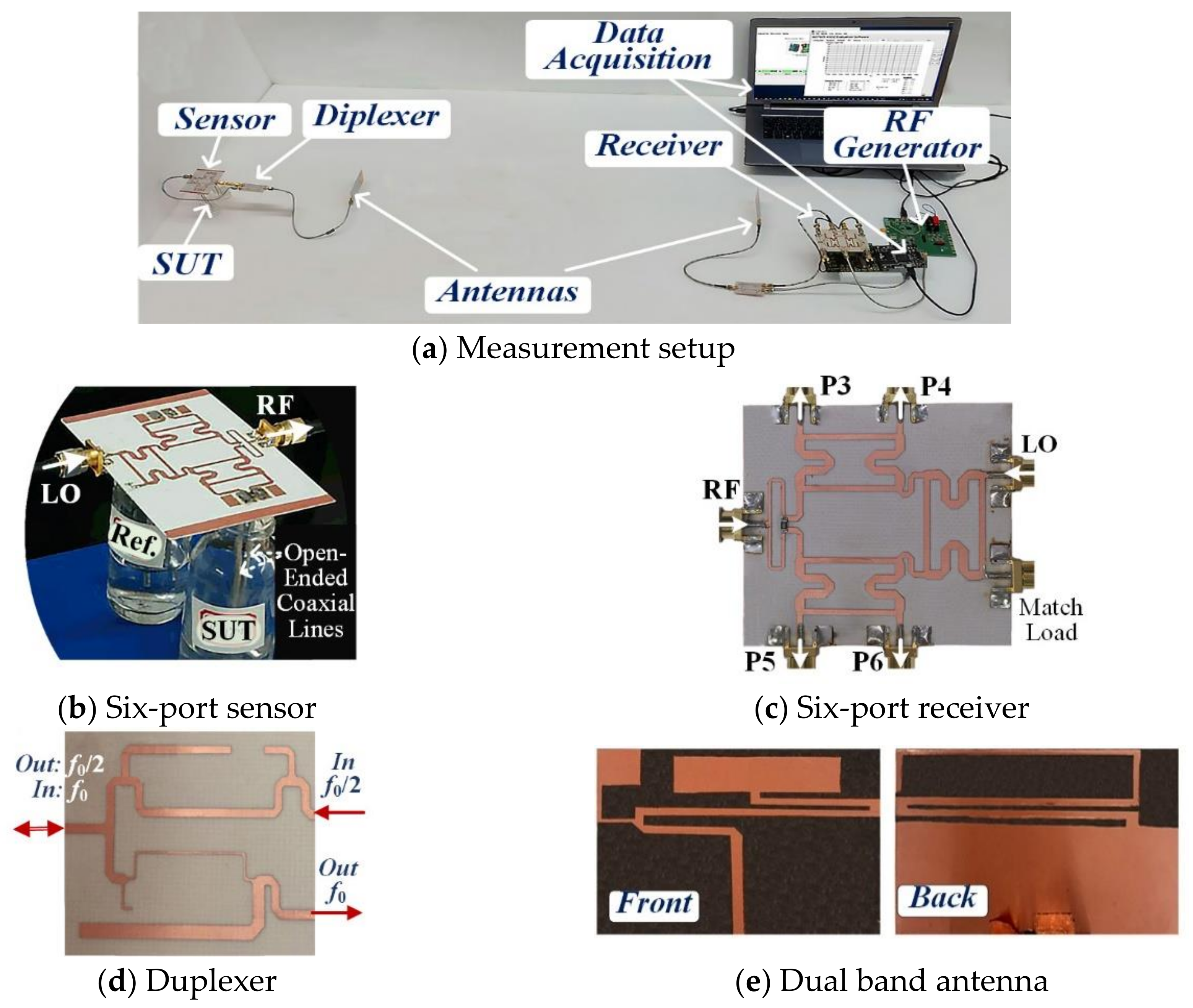


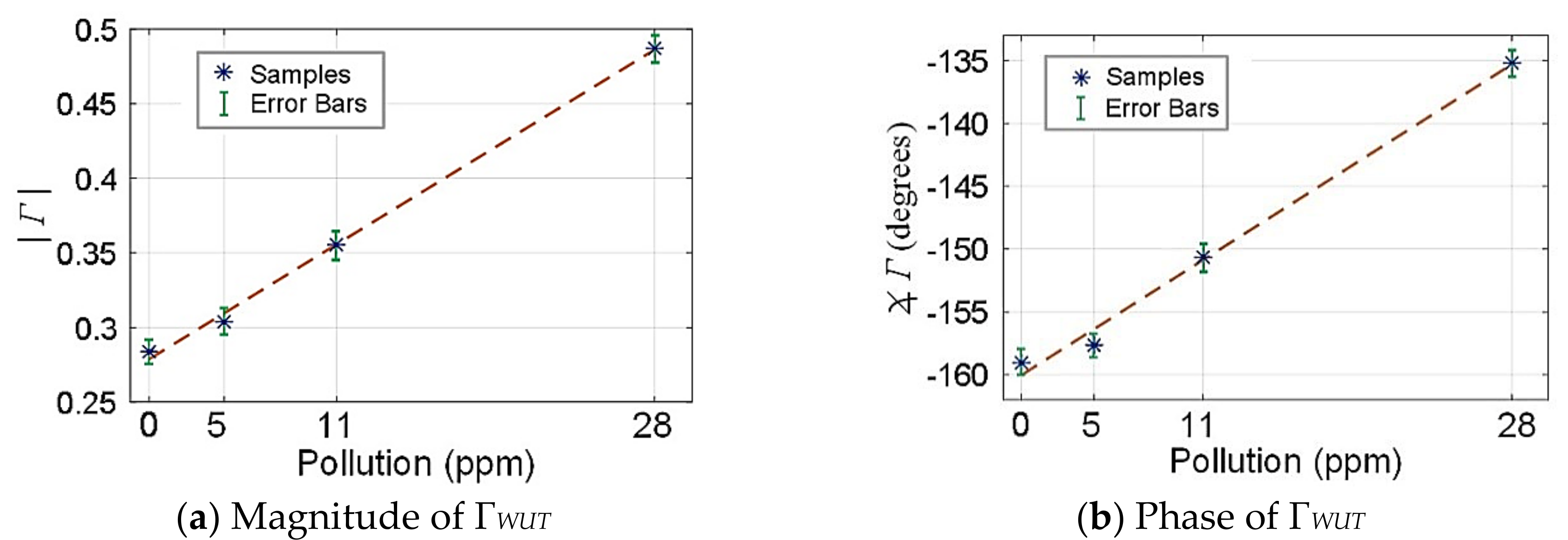
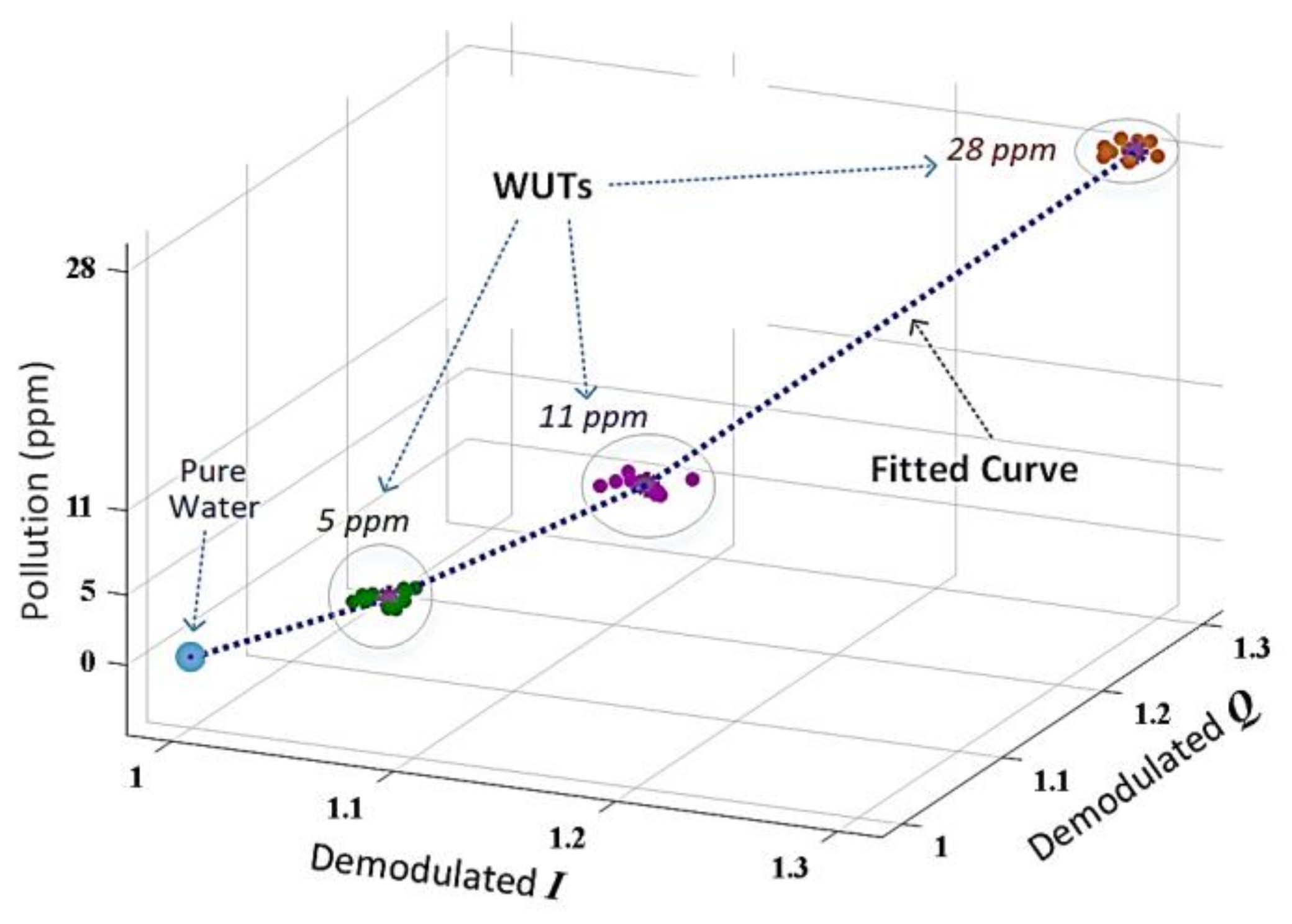
| Parameter | (mm) | Parameter | (mm) |
|---|---|---|---|
| 1.13 | 5.00 | ||
| 1.91 | 18.8 | ||
| 0.62 | 8.50 | ||
| 0.30 | 22.4 | ||
| s | 0.70 | 10.2 |
| Parameter | (mm) | Parameter | (mm) | Parameter | (mm) | Parameter | (mm) |
|---|---|---|---|---|---|---|---|
| 1.13 | 5.00 | 1.13 | 7.00 | ||||
| 0.85 | 18.8 | 1.02 | 30.3 | ||||
| 0.85 | 7.20 | 1.13 | 4.80 | ||||
| 1.13 | 32.6 | 1.13 | 7.00 | ||||
| 0.3 | 4.40 | 0.25 | 4.3 | ||||
| 1.70 | 31.2 | 1.13 | 20.3 | ||||
| 36.5 | 10.1 | 2.525 | 8.67 | ||||
| 9.1 | 1.11 | 0.508 | 62 | ||||
| 0.47 | 111.67 | 1.22 | 2.225 | ||||
| 53.3 | 29.67 | 2.2 | 18.65 |
© 2018 by the authors. Licensee MDPI, Basel, Switzerland. This article is an open access article distributed under the terms and conditions of the Creative Commons Attribution (CC BY) license (http://creativecommons.org/licenses/by/4.0/).
Share and Cite
Mirzavand, R.; Honari, M.M.; Laribi, B.; Khorshidi, B.; Sadrzadeh, M.; Mousavi, P. An Unpowered Sensor Node for Real-Time Water Quality Assessment (Humic Acid Detection). Electronics 2018, 7, 231. https://doi.org/10.3390/electronics7100231
Mirzavand R, Honari MM, Laribi B, Khorshidi B, Sadrzadeh M, Mousavi P. An Unpowered Sensor Node for Real-Time Water Quality Assessment (Humic Acid Detection). Electronics. 2018; 7(10):231. https://doi.org/10.3390/electronics7100231
Chicago/Turabian StyleMirzavand, Rashid, Mohammad Mahdi Honari, Bahareh Laribi, Behnam Khorshidi, Mohtada Sadrzadeh, and Pedram Mousavi. 2018. "An Unpowered Sensor Node for Real-Time Water Quality Assessment (Humic Acid Detection)" Electronics 7, no. 10: 231. https://doi.org/10.3390/electronics7100231






